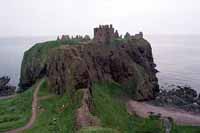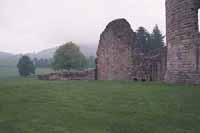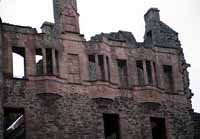
S c o t l a n d
d a y 1 4
Travel Home
Travelogue
Planning
Resources
Itinerary
Scottish Castles
Abbeys and Kirks
Other sights
email Phouka
f r i d a y m a y 2 8 1 9 9 9
Leaving Montrose, we headed off on the Castle Trail. First, though, we ran up the coast to see Dunnottar Castle, which is amazing. This enormous old ruin sits out on a huge crag of rock, and it probably one of the most recognized castles in Scotland. It's quite ruined, of course, but the caretaker says that the owners (the Castle is in private hands) still come out twice a year to have picnics. Of course, now they land on the grounds in their helicopter, but they take advantage of the refurbishments carried out in 1864 which put windows and a roof on some of the buildings.
 It rained, even though we blithely assured everyone in the carpark that it would stop and would be sunny. Hah! It started with the 'fine Scottish mist' type of rain, and turned the staircase into a muddy mess.It was still a neat castle. We went down the side path through the narrow passageway to the beach.
It rained, even though we blithely assured everyone in the carpark that it would stop and would be sunny. Hah! It started with the 'fine Scottish mist' type of rain, and turned the staircase into a muddy mess.It was still a neat castle. We went down the side path through the narrow passageway to the beach.
There is only one way in to Dunnottar. Mark scampered down the clffside to the beach for some pictures. We also hopped the fence and wandered out into the sheep field on the cliffs opposite the castle. I've seen gorgeous pictures of Dunnottar in the setting sun, all golden-red against the sky. Ours are a bit more gray, I'm afraid.
The castle had to have been a small, fairly self-sufficient city, since it was nearly inaccessible from the landward side. There was a smithy, stables, bakehouse, brewery among the buildings still standing. Living here must have been pretty comfortable, actually. Now, of course, there is not much left of most buildings, just a shell of a wall or a fragment of the foundations.
Mark was impressed with the fortifications and defensibility of the castle. It was difficult to get to the front gate even if you were expected -- doubly so if you were attacking! The island is only reached by a thin spit of land from the mainland, over the spine of the bridge and then to a main gateway guarded by gun loops and cannon. Then, through the main gate, visitors would climb a steep hill to the inner gate, also guarded by gun loops and steep stone walls.
Inside, the buildings ring a central courtyard, with the newer, taller, towerhouse at one end. There is a huge round pool of some sort in the center of the grounds -- it looks to be a cistern, though for drinking water or washing, we don't know. Inside the Hall, which has been meticulously restored, the ceilings have been paneled and some furniture has been added.
We started following the Castle Trail from Aberdeen, although many of the castles were of the "completely restored museums" type. Too many velvet ropes and reconstructed rooms for me. They just don't interest me as much as the derelict old ruins we've been visiting. Maybe too much is finished. There's not as much left to the imagination in these restored versions. In the ruins, I can just sit in the window seat and close my eyes and see and hear what life must have been like in these stone piles. The roaring fires, musicians, servants scurrying from kitchen to hall. The restored versions look a little too fake, a little too rehearsed. Too perfect. They are not often restored historically, more often they are carefully designed (and contrived) galleries. Some are even advertised as galleries, with no intention of being realistic or even appropriate.
 We were pretty soggy after Dunnottar, but bravely headed out into the mist. It took a bit to find Kildrummy Castle, which was on my list of "must-see's". Kildrummy is a very large castle, with very distinctive drum towers, although it is very ruined. It was raining in earnest, so I don't know how well the pictures will turn out -- I had to hold the camera under the hood of my coat to keep it out of the rain. Not much stands here except the bases of the two drum towers, some 30' across. The castle is almost perfectly symmetrical. Mark is cold and wet, so we didn't stay long. We did stop by Glenbuchat, but it was really raining too hard to get any pictures at all, and windy enough we stayed in the car. phbbbt.
We were pretty soggy after Dunnottar, but bravely headed out into the mist. It took a bit to find Kildrummy Castle, which was on my list of "must-see's". Kildrummy is a very large castle, with very distinctive drum towers, although it is very ruined. It was raining in earnest, so I don't know how well the pictures will turn out -- I had to hold the camera under the hood of my coat to keep it out of the rain. Not much stands here except the bases of the two drum towers, some 30' across. The castle is almost perfectly symmetrical. Mark is cold and wet, so we didn't stay long. We did stop by Glenbuchat, but it was really raining too hard to get any pictures at all, and windy enough we stayed in the car. phbbbt.
On the way through Strathdon, we had been talking about the fact that each town seemed to have this huge monument to the soldiers lost in World War I, but often only a tiny addendum to the monument for those from World War II. Admittedly, fewer men were lost, but it seems to shortchange the WWII veterans. Anyways, Strathdon had a tall stone monument set in a little traffic triangle. Mark makes an abrupt turn to circle round and look at the names. He can't make a complete circle, and stops to back up and try again. I look up, and there it is.
I can't believe that we actually found it! After finding a postcard with the little road sign on it almost a week ago, we had joked about trying to find it. It wasn't listed on any map we had, nor in any guidebook. Now, here, completely by accident, we nearly fell over it.
 We leapt out of the car and literally danced around the sign, taking picture after picture. Mark even dug out the tripod so we could take pictures of us beneath the sign. I couldn't believe it! Wow! Everyone else drives on past, and these bizarre American tourists are by the side of the road taking pictures of a road sign. Of course, we've been taking road sign pictures all during our trip -- my favorite has to be the frog crossing sign and the 'oncoming traffic in middle of road' signs.
We leapt out of the car and literally danced around the sign, taking picture after picture. Mark even dug out the tripod so we could take pictures of us beneath the sign. I couldn't believe it! Wow! Everyone else drives on past, and these bizarre American tourists are by the side of the road taking pictures of a road sign. Of course, we've been taking road sign pictures all during our trip -- my favorite has to be the frog crossing sign and the 'oncoming traffic in middle of road' signs.
We drove down the road looking for Lost, and the road dead ended at a cattle gate and petered off into the field. We later found out that Lost is really Lost Glen, and we had driven out into the middle of it.
Corgarff Castle was interesting since it was so tiny. It was designed specifically as a barracks for a garrison of troops. This was never meant to be a stronghold (although with the strange star-shaped wall it would have been easy to defend), and was restored to look as it would have when it garrisoned troops. They heated the tower with peat and charcoal fires, and the smoke and smell gave me a horrific headache. I can't imagine living there in winter when it would have been smokey and dark and smelly.
 Figuring we'd better start heading towards the hotel, we stopped at Huntly Castle. It is very sumptuous, and while not meant for defense, it is nonetheless very imposing. The Castle is very sumptuous, with intricately carved fireplaces and original plasterwork. The Lord of Huntly built himself a very fine house. You can faintly see the remains of the older fortress here, in the wide foundation walls and outbuildings, but the site is dominated by the tower with it's rare oriel windows.
Figuring we'd better start heading towards the hotel, we stopped at Huntly Castle. It is very sumptuous, and while not meant for defense, it is nonetheless very imposing. The Castle is very sumptuous, with intricately carved fireplaces and original plasterwork. The Lord of Huntly built himself a very fine house. You can faintly see the remains of the older fortress here, in the wide foundation walls and outbuildings, but the site is dominated by the tower with it's rare oriel windows.
We stopped near Huntly Port on our way out of town.
Our hotel for the night, the Old Manse at Marnoch, was stunning. It's a restored 15c house, lovingly cared for and restored by the older couple who own the place, since 1988. The room we stayed in was beautiful, and everything was quite elegant. We got there about 6:30 and were informed politely that dinner was at "7:30 for 8:00" and to meet in the lounge for the menu.
Ok, we had no idea just what "7:30 for 8:00" meant, but we were down in the lounge at 7:00 to meet the other guests and see the menu. We had a glass of wine with a couple from London and a German family. It was quite nice to relax and talk to them.
I ordered Baby Haggis as an appetizer and Mark had smoked trout. Then, for dinner, WOOD PIGEON. I can now say that I've had both Haggis and Pigeon. Whew! Where on earth do you buy wood pigeon? After dinner, we retired to the lounge for coffee and drinks. Mark actually had a Scotch and was quite proud of the fact that he could tell the difference between this (12 year old Talisker) and the Glenturret we had at the distillery. I can't say that I'm a scotch fan, but it's interesting.
Another English couple (once again from London, I think) came by after dinner. Duncan and Helen were in town for a wedding, and we stayed up until 2:00 am talking. It was great! Mark and I got to be the resident Americans for the evening -- apparently they don't often have guests from the States -- and we got to discuss wedding differences. Apparently here, the "bachelorette party" is referred to as a "hen party". We never did ask what they called the "bachelor" party...
©1999-2001 R. Fingerson